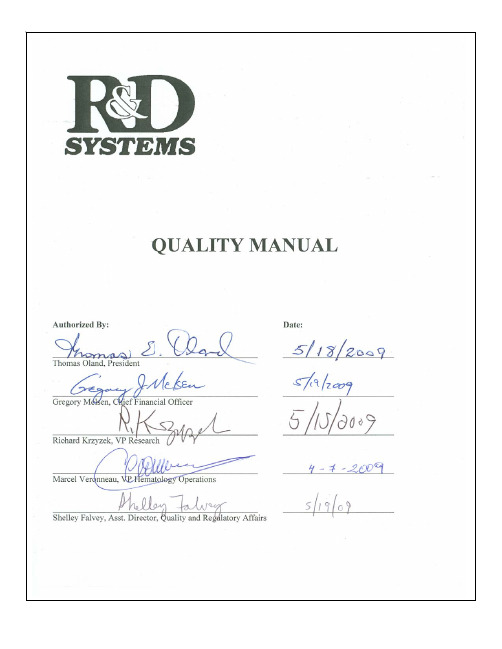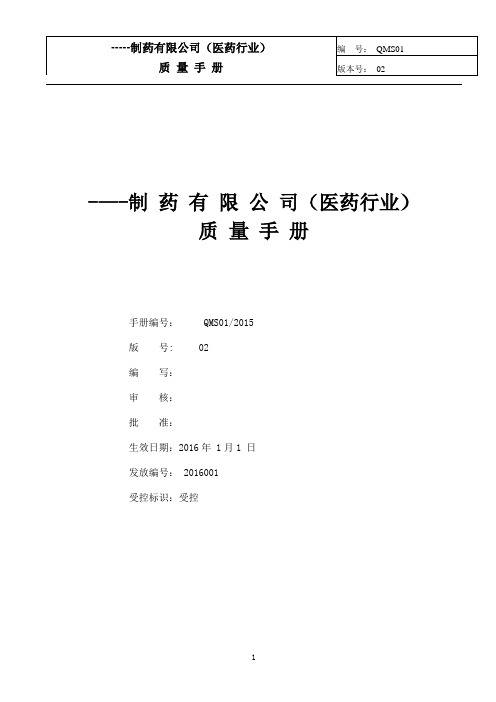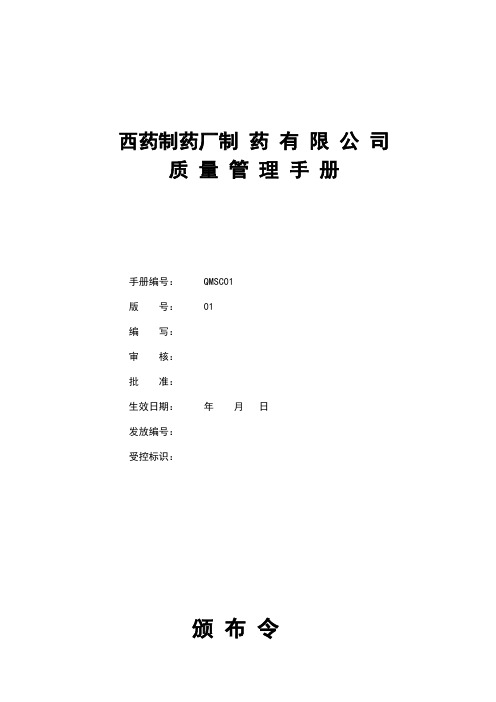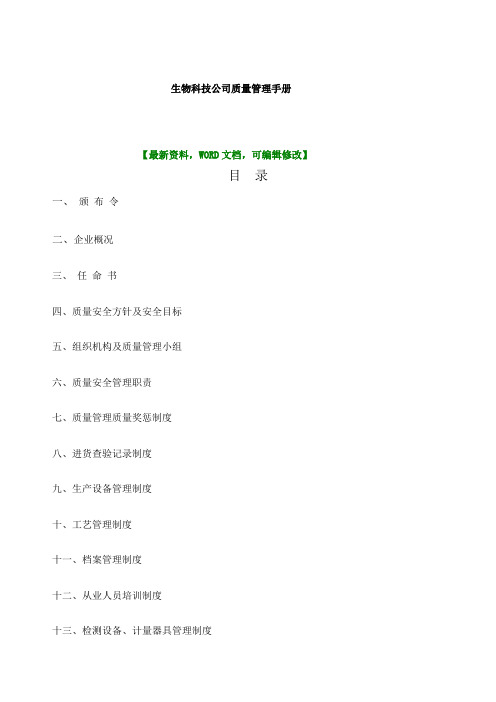生物科技药业公司质量手册
quality manual(生物科技质量手册)

QUALITY MANUALAuthorized By: Date:________________________________________________ __________________________ Thomas Oland, President________________________________________________ __________________________ Gregory Melsen, Chief Financial Officer________________________________________________ __________________________ Richard Krzyzek, VP Research________________________________________________ __________________________ Marcel Veronneau, VP Hematology Operations________________________________________________ __________________________ Shelley Falvey, Asst. Director, Quality and Regulatory AffairsQUALITY MANUAL SECTIONTITLE: CONTENTS Number: 540308 Revision: 11 Supersedes:540308.10 Section: 1.1Page: 1 of 1 Revision Date:4/2/09QUALITY MANUAL CONTENTS Section 11.1Page 1 Quality Manual Contents1.2Page 2 Quality Policy1.3Page 3 Company ProfileSection 2Quality System Requirements:2.1 Page 4, 5, 6 Management Responsibilities2.2 Page 7 Quality Audits2.3 Page 8 Personnel2.4 Page 9 Design Controls2.5 Page 10 Document Controls2.6 Page 11 Purchasing Controls2.7 Page 12 Identification and Traceability2.8 Page 13, 14 Production and Process Control2.9 Page 15 Acceptance Activities2.10 Page 16 Non-Conforming Product2.11 Page 17 Corrective and Preventive Action2.12 Page 18 Statistical Techniques2.13 Page 19 Labeling and Packaging Control2.14 Page 20 Material Handling, Storage and Distribution2.15 Page 21 RecordsPage: 1 of 1Revision Date: 4/2/2009R&D Systems Inc. Quality Policy:R&D Systems is committed to the highest level of quality in the manufacture, sale and support of our products. Product quality, compliance to all applicable regulatory requirements, continuous improvement and customer satisfaction shall underlie all of our efforts in development, manufacturing, advertising, sales, shipping and technical support.Definitions:Quality : the totality of features and characteristics that bear on the ability of a product to satisfy fitness for use, including safety and performance (§ 820.3 (s)).Quality system : the organizational structure, responsibilities, procedures, processes and resources for implementing quality management (§ 820.3 (v)).Assurance of quality and integrity are the responsibility of:1. the President, who has responsibility for creation of an atmosphere of high standards;2. the officers, directors, managers and supervisors, who are charged with development and implementation of quality systems; and3. each employee, who is responsible for the quality of his or her work and for suggesting improvements in quality.This Quality Manual is the top tier of our documentation system. It gives an overview of our Quality System. It is supported by corporate and division standard operating procedures (SOPs) which are the second tier of our Quality System documents and are listed in this Quality Manual. The third tier of the documentation system consists of manufacturing/testing documents, forms and specifications developed by each operating unit.Our policies are in conformance with the applicable requirements of the Code of FederalRegulations (21 CFR) Quality Systems Regulations for Medical Devices; ISO 13485 Standard: 2003, ISO 9001 Standard: 2008, the In Vitro Diagnostic Directive 98/79 EC and the Canadian Medical Device Regulations.Sections of the ISO 13485 Standard which do not apply to R&D Systems are as follows: Section 7.5.1.2.3 - Service activities (Reason: Applicable to equipment) Section 7.5.1.2.2 - Installation activities (Reason: Applicable to equipment) Section 7.5.1.3 -Section 7.5.2.2 - Particular requirements for sterile medical devices (Reason: No sterile products)Section 7.5.3.2.2Section 8.2.4.2 - Particular requirements for active implantable devices (Reason: No implantable devices)Related Procedures:540007 Canadian Medical Device License, Facility License and Quality SystemCertification540120 Required Standards Listing, Maintenance and Review}}Page: 1 of 1Revision Date: 4/2/2009R&D Systems was founded in 1976 in Minneapolis, MN. It is a wholly owned subsidiary of TECHNE Corporation (a holding company with no employees). The stock is traded publicly on NASDAQ’s National Market System under the “TECH” symbol. TECHNE has two operating subsidiaries: Research & Diagnostics Systems, Inc. (R&D Systems) and R&D Systems Europe Ltd. (R&D Europe).R&D Systems has two operating divisions: Biotechnology, which manufactures reagents primarily for the research market, and Hematology, which manufactures controls and calibrators for hematology analyzers. The Minneapolis manufacturing facility is certified to ISO 9001:2008 and ISO 13485:2003. The ISO Certificate numbers are FM547845 and FM547846, respectively. In July, 2005 R&D Systems purchased BiosPacific, which became a wholly owned subsidiary. BiosPacific is located in Emeryville, CA and consists of a sales force which provides raw materials for development of Immunoassay kits.R&D Systems Europe in Abingdon, England distributes biotechnology products and is the European Representative for the Biotech Division. They received ISO 9001: 2000 certification in June, 2007. Their ISO Certificate number is 951074360. EuroCell Diagnostics, Village de la Metairie Batiment B, 35131 Chartes de Bretagne is the European Representative for the Hematology Division.R&D Systems Europe has a sales subsidiary, R&D Systems GmBH, in Germany.R&D Systems established a wholly owned subsidiary in the People's Republic of China in May 2007. R&D Systems China Co. Ltd. opened its Warehouse and Distribution Center in Shanghai, China on October 1, 2007. R&D China provides products, marketing and technical support to our Chinese distributors.R&D Systems’ physical plant includes over 498,460 square feet of laboratory, manufacturing, shipping and office space as of December 1, 2008. Offices are in Minneapolis, MN, Abingdon, UK, Wiesbaden, Germany, Shanghai, China and Emeryville, CA with over 665 employees as of December 1, 2008.Section Title: Management Responsibilities Section: 2.1Page: 1 of 3Revision Date: 4/2/2009 Quality is the responsibility of each employee throughout our organization.Management is responsible for communicating our Quality Policy to all employees and for ensuring full understanding of, and commitment to, quality.∙The President has executive responsibility for the Quality System and is responsible for creating an atmosphere where quality is the highest priority.∙The Vice Presidents are responsible for overseeing the development, implementation and maintenance of the Quality System.∙The Asst. Director, Quality has been appointed as the Management Representative by the company president. The Management Representative has responsibility for ensuring that quality requirements are effectively established and maintained in accordance with theappropriate regulations and for reporting on the quality system to upper Management.∙The Asst. Director, Quality, Vice President of Operations (Hematology), and the Quality Assurance (QA) staff are responsible for ensuring that our quality system is fully maintained and implemented.∙Each director, manager and supervisor is responsible for assuring that Quality Systems are followed in his or her area.∙Each employee is responsible for the quality of his or her work.Two groups are dedicated exclusively to Quality:1. The Quality Assurance Department assists operating departments in the development ofquality systems and conducts periodic audits to assure that those systems are implemented faithfully and effectively. Quality Assurance has the responsibility to:∙identify and evaluate quality-related problems.∙recommend solutions to quality problems and verify that any problems have been resolved (corrective actions).∙initiate action to prevent the occurrence of quality problems (preventive actions).∙control non-conforming products until corrective action has been taken.∙set quality goals and objectives for the company and develop plans to meet those goals and objectives.∙report to Management on quality related issues.The Quality Assurance Department is responsible for quality systems, but implementation of these systems and quality per se is the responsibility of each director, manager, supervisor and employee.2. The Quality Control (QC) Departments inspect and test products at all stages of themanufacturing process, from raw materials to finished goods. Quality Control Managers have responsibility for product release against predetermined specifications. Due to the varied and highly technical nature of our products, QC functions are distributed throughout the corporation to ensure that testing and inspection are done expertly.The following charts describe the organizational and functional structure of the Company. While the structure and organization of the Quality function varies between the two divisions of R&D Systems, their goals are identical.Related Procedures:540009 Management Quality Systems Review ProcedureOrganizationAssurance541138 QualityQUALITY MANUALSection Title: Management ResponsibilitiesNumber: 540308Revision: 11Supersedes: 540308.10Section: 2.1Page: 2 of 3Revision Date: 4/2/2009 Quality Systems Flow ChartSection Title: Quality Audits Section: 2.2Page: 1 of 1Revision Date: 4/2/2009 Periodic audits assure adherence to our quality systems.Internal Quality System audits are performed by the Quality Assurance staff and by other trained personnel under the guidance of Quality Assurance. Results of audits are reported to the Assistant Director of Quality, the appropriate Vice President, the Company President, and the operating units involved. It is the responsibility of those units to develop corrective actions, to correct deficiencies and to present evidence of correction.Vendor audits are performed by Quality Assurance staff on an as needed basis.Other Quality System effectiveness checks are made by department managers and senior management, through periodic review of product complaints, non-conforming material tracking/trending and material review board meeting minutes.To ensure that the Quality System is effective and relevant, it is reviewed annually by the Senior Management Team, the Asst. Director of Quality, the Regulatory Affairs Specialist and other managers, as appropriate. The agenda for the meeting will be written by Quality Assurance based upon audit results and other outstanding issues related to Quality Systems and product quality. Minutes from the meetings shall be distributed to those present at the meeting as well as any designated attendees that are absent from the meeting. A copy of the agenda and meeting minutes will be maintained on file in Quality Assurance.Related Procedures:Corporate:540009 Management Quality Systems Review ProcedureMeetings541131 Quality540167 FDA Inspection Procedure540291 Internal Audit Procedure540335 Vendor Audit Procedure540552 Corrective and Preventive ActionBiotechnology:540135 Customer Feedback System, Biotech540259 Material Review Board Responsibility Procedure540550 Quality Assurance Auditing of GLP StudiesHematology:6016 Material Review Board Procedure8034 Technical Service Protocol/ComplaintsPage: 1 of 1Revision Date: 4/2/2009It is our policy to hire only qualified personnel and to assure that they are trained in all aspects of their jobs.Copies of job descriptions, job applications, resumes and annual performance reviews are kept on file in the Human Resources Department.The Company has a QSR/GMP training program (including the applicable regulations), conducted by Quality Assurance, which all employees are required to complete. Upon satisfactory completion of this training by an employee, a certificate of completion is given to the employee’s supervisor. Quality Assurance maintains a master log of all certificates of completion issued. Ongoing training, as necessary, assures personnel are familiar with applicable requirements.The Company has provided ISO 13485/CMDR and risk analysis training to Managers and Directors responsible for the manufacture and testing of our products. It is the responsibility of these trained employees to assure that all of their employees are familiar with the pertinent aspects of these regulations.Regulatory Affairs maintains a file of all pertinent Standards and assures that the latest revisions are available. When revisions are available, this is communicated to Quality Assurance and other pertinent personnel so that we can keep up-to-date on the latest regulations and standards. Each department maintains job-specific training records for its employees. Supervisors are responsible for job-specific training, for training on new or revised documents, for assuring that training is effective and for maintaining training records. Notification of document changes are issued as a trigger for training.Related procedures:540189 Personnel Training Procedure540816 Procedure for Generating Training Reports540120 Required Standards Listing, Maintenance and ReviewPage: 1 of 1Revision Date: 4/2/2009 We have different Design Controls for different types of products. In general, they cover the following points.1. Approval of the design goals (Design Input)2. Review of feasibility studies (Design Review)3. Approval of the product description (Design Output)4. Review of process development and preparation of manufacturing documents (DesignVerification Review)5. Review and approval of product validation (Final Design Review/Data Review)6. Transfer to manufacturingThe specific procedures for the different product lines are referenced below.Related Procedures:Biotechnology540045 Definition of Product Design Goals for Assay DevelopmentControls540325 Design540266 Procedural Elements in a Validation540215 Specific Immunoassay Validation Procedures (i.e., Linearity, Precision, etc.) 540217 through 540221, 540223, 540235 - 540238, 540288, 540337, 540409, 540729, 540804 and 541002Hematology6009 Procedural Elements in a Validation6009A Testing Protocol Request3421 Procedure for Developing Operational Procedures6015 Product Introduction/Product Improvement Procedure6015A Design Control and Transfer Worksheet6039 Product Development Request Form6026 Design Input6027 Design Output6040 Design Review ProcedureCorporate540819 Risk Analysis and ManagementPage: 1 of 1Revision Date: 4/2/2009To assure consistent quality, we use written, approved procedures for all operations. The Document Control and Quality Assurance departments or their designee(s) are responsible for controlling the issue, distribution, revision and archiving of these procedures.The documents that must be controlled include:The Quality Manual and Quality Systems SOPsDevice Master RecordsInternal Audit ReportsStandard Operating ProceduresManufacturing ProceduresTesting/Inspection ProceduresCalibration and Maintenance RecordsDevice History RecordsDesign Control RecordsFormsData from ATS StudiesEssential Requirements and Technical Document IndexesBiotechnology uses a formal Document Change Request (DCR) procedure for creating new documents and revising existing documents. It involves review and approval by multiple departments generally including a technical department, the affected department and the Quality Assurance department. The Hematology Division initiates formal Document Control in each Department. The Departmental Supervisor reviews a draft with assistance from designated individuals.Related Procedures:Corporate540643 Standard Operating Procedure (SOP) Review Procedure540578 Record Keeping GuidelinesDocumenta540146 Creating540748 MasterControl™ Electronic Documentation SystemFunctions540750 MasterControl™Biotechnology540205 Document Change Request ProcedureMaintenanceof Document Master Files&540382 Preparation540411 Master Document Replacement Procedure540532 Data Management: General Procedures & Definitions (ATS Lab) Hematology3007 New and Updated Procedure Protocols3008 Procedure Format6005 Document Organization (Document Control)3421 Procedure for Developing Operational Procedures6006 Updating the Device Master Record (DMR)6030 Format for "Product Description/Device Specifications" Documents6031 Format for "Product Type" DocumentsPage: 1 of 1Revision Date: 4/2/2009 Consistent quality of raw materials and contracted services is a key part of our quality system. Purchasing control covers the following areas:∙Specifications: Requirements for raw materials are stated in written specifications available to all personnel doing purchasing and receiving activities.∙Vendor Control: Qualified vendors are listed on each raw material specification. Document 540000, Vendor Qualification describes how to qualify new vendors in Biotechnology and Hematology including outsourced services and processes. Vendor performance is tracked and Vendors who do not perform well may be disqualified and replaced.∙Purchasing Control: The purchase order includes our part number and a request for a Certificate of Analysis where appropriate. All materials used in the manufacture of products are verified against the purchase order. Purchasing interacts with suppliers regarding non-conforming or damaged materials.∙Contract and Supply Agreements: Purchasing, Sales or Business Development is responsible to assure customer contracts and supply agreements are in place when required. Intellectual property contracts, customer contracts and supply agreements are managed by the Corporate Legal Department.Related Procedures:SystemsR&DProcedure,540687 PurchasingR&DSystems540192 ReceivingProcedure,Qualification540000 VendorProcedureAudit540335 VendorProcedure540876 QuarantinedProduct540805 Policy Regarding Contracts and Supply AgreementsRawMaterials Specifications (Biotech)640xxx Non-biologicalMaterial Specifications (Biotech)Raw645xxx Biological54xx, 55xx Biological Raw Material Specifications (Hematology)56xx, 57xx Non-biological Raw Materials Specifications (Hematology)Section Title: Identification and Traceability Section: 2.7Page: 1 of 1Revision Date: 4/2/2009The ability to trace a lot of product back to all raw materials used in its manufacture and to trace any lot of raw material to products it became part of is an essential feature of our Quality System.A part number and lot number (or receiving number) control all materials used to manufacture products. This provides complete traceability from receipt of raw materials through final shipment to the customer. In Biotechnology, Document Control is responsible for assigning part numbers. An MRP System (RenCS) is in place in the ELISA kit manufacturing area which is used to track inventory, assign job (lot) numbers and plan the production of the ELISA products. Lot numbers for all other products may be sequentially assigned from the Lot Number Database or are assigned at the time of bottling.The Hematology Director of Operations assigns final product lot numbers for Hematology products.Receiving departments are responsible for assigning receiving numbers to incoming raw materials.Related Procedures:540153 Part Number Assignment (Biotech)540523 Electronic Part Number Requisition Procedure540206 Lot Number Assignment (Biotech)540540 Receiving of Specimens for RDS-ATS Lab540831 RenCS, Add and Maintain Part Records8862 Assigning Final Product Lot Numbers (Hematology)6019 Identification and Traceability (Hematology)Page: 1 of 2Revision Date: 4/2/2009We design quality into our products. Areas of the manufacturing process that require control are identified during the development of a product and the effects of variables and appropriate limits are established.Process Control is accomplished through planning, written procedures, inspection, calibration, training, supervisory oversight and employee awareness. Changes to the manufacturing process, if required, are controlled, qualified and validated.∙Written procedures provide bills of materials, instructions for production, equipment required, working environment, filling and labeling instructions, record sheets, expiration dating, in-process testing, and acceptance criteria.∙Monitoring of product manufacture is accomplished through the use of Batch Records (Device History Records) containing the current revisions of the documents required for the manufacture of a product. Document Control assembles batch records for kit component manufacturing. Other manufacturing and Quality Control departments print official copies of their documents from MasterControl™. Operations, in Hematology, assembles the batch records. Quality Control verifies compliance through review and approval of completed batch records prior to final product release.∙The Specification Deviation Procedure handles deviations from the written procedures.∙All new inspection, measuring and test equipment is inspected and validated, when appropriate, against manufacturer’s specifications and identified with a permanent preventive maintenance number. Equipment is calibrated on a regular schedule. Improperly maintained or calibrated equipment will not be used. Records of calibration and maintenance aremaintained by the Facilities & Equipment Department. Quality Assurance audits equipment periodically, to ensure that calibration is proceeding according to schedule.∙The supervisor or lead personnel contributes to quality through training employees, assisting employees with new or specialized processes, interpreting instructions for andcommunicating process changes to employees.Related Procedures:ProcedureDeviation540126 Specification540142 Procedure for Documentation of Equipment Maintenance and/or Calibration 540310 Software Validation540133 Internal Notification Procedure: Receipt of New EquipmentPage: 2 of 2Revision Date: 4/2/2009 Biotechnology540781 Planning Guidelines, Immunoassay Manufacturing540834 RenCS, Recipe Authorization540833 RenCS, Add, Copy and Maintain a Process Specification540832 RenCS, Adding and Copying a Recipe540207 Product Finishing Label Control540072 Filling Operations Procedure540267 Preparation, Completion and Approval of Batch Records540278 Bottling Procedure for Cytokines and Antibodies Designated for Retail Sale 540256 Labeling Procedure for Cytokines and Antibodies Designated for Retail Sale 540134 Incoming Equipment Validation Procedure540503 Process Deviation Form, Dept 374540657 Process Deviation Form, Dept 375 and 394Hematology9090 Product Finishing Label Control9054 Bottling Procedure8812 Finished Device Inspection Procedure8813 Guideline for Determining Assay Ranges8006 Bottled Product Release8809 Assay Sheet Printing and Release6009A Testing Protocol Request6017 Product Type, Product Type Revision, Product Change NotificationSection Title: Acceptance Activities Section: 2.9Page: 1 of 1Revision Date: 4/2/2009 Acceptance/inspection activities are critical to the manufacture of quality products.∙Incoming materials are received in accordance with documented procedure(s).∙Deliveries are inspected against the purchase order for type, quantity and external transit damage. Additional inspection may include verification against Certificates of Analysis, in-house material specifications or incoming testing procedures.∙In-process testing is specified by the manufacturing and/or Quality Control procedures.Testing may include the recording of physical parameters such as pH and temperature, actual functionality testing and/or visual inspection.∙Final inspection and testing are completed before any product is released for sale. Quality Control signs the product release forms. Proteins and antibodies are released by the Director of Manufacturing. All documentation is reviewed and the product is physically inspected before release stickers are placed on the product and batch record.All inspections and testing must be supported by completed documentation. Release by exception must be documented and approved by the Material Review Board. Such approval must be documented.Related Procedures:540192 Receiving Procedure, R&D Systems540080 Raw Materials Departmental Receiving and Inspection Procedure540124 Inspection of Assembled Kits540143 Literature and Label Approval Procedure550449 Immunoassay Approval/Rejection Criteria540267 Preparation, Completion and Approval of Batch Records540526 Receiving of OEM Products540363 Releasing Retail Product540194 Certificate of Analysis Procedure541138 Quality Assurance Organization8812 Finished Device Inspection Procedure (Hematology)Section Title: Non-Conforming Product Section: 2.10Page: 1 of 1Revision Date: 4/2/2009Our quality system provides for the identification, documentation, evaluation, segregation, and disposition of non-conforming product.Quality Assurance administers the non-conforming materials system with the participation of the Material Review Board (MRB). Within departments producing research use only materials, appropriate technical personnel will review non-conforming material and make decisions concerning disposition of that material. Any employee with knowledge ofnon-conforming material may call for a Material Review Board meeting. Minornon-conformities may be released by Quality Control with adequate documentation. Disposition of major non-conformities lies with the MRB. QA is responsible for documenting the activities of the MRB. The Biotech MRB is composed of representatives from Quality, Manufacturing, and Development. Additional representatives from Product Support, Marketing, Technical Service or Sales may also participate as required. All corrective actions must be fully documented. Minutes from meetings of the MRB are published and maintained in MasterControl™.In Hematology, MRBs are documented using the Material Review Board (MRB) form. Minutes from meetings of the MRB are published and maintained in MasterControl™. A summary of MRBs is distributed quarterly to managers for review.All non-conforming material is clearly marked with Quarantine stickers or labeled appropriately. In addition, it is physically separated from conforming material until final disposition.A Specification Deviation is issued for any deviation in the manufacturing procedure even if it ultimately meets final release specifications. If a product is reworked, it must undergo all required inspections and tests as well as any additional inspection or testing required by the MRB. Reworked material must pass the same release criteria as the original product.Related Procedures:ProcedureDeviation540126 Specification540552 Corrective and Preventive Action540259 Material Review Board Responsibility ProcedureProcedure540265 Reprocessing540330 Procedure for Quarantine/Rejecting Approved Product (Biotech)3009 Adjustment/Replacement of a Finished Product (Hematology)6016 Material Review Board Procedure (Hematology)1012 Rework Procedure (Hematology)541214 Corrections, Removals and Recalls for IVD Products。
制药行业质量控制手册

制药行业质量控制手册一、引言制药行业的质量控制是确保药品安全和有效性的关键步骤。
本手册旨在提供制药企业关于质量控制的详细指导,以确保产品的一致性和质量符合国家和国际标准。
二、质量方针本企业致力于提供符合法规要求、安全有效的药品和医疗产品,以保障顾客及患者的满意度和健康。
我们严格遵守国家药品监管部门的规定,并持续改进质量管理体系,确保产品的质量和可靠性。
三、组织结构与职责1. 质量控制部门负责制定并执行质量控制策略,确保制品符合GMP及其他适用的质量标准和法规要求。
2. 生产部门负责按照质量控制部门的要求制造产品,并确保所生产的产品符合质量标准。
3. 质量保证部门负责审核和评估质量控制系统的有效性,并监管各部门贯彻执行质量要求。
四、质量控制流程1. 原料及辅料控制a) 质量控制部门负责建立严格的原料控制流程,确保原料的质量符合标准。
b) 生产部门对原料进行验收,并按照规定的程序进行入库管理。
c) 质量保证部门定期对入库原料进行抽样检测,确保其质量合格。
2. 生产过程控制a) 生产部门根据质量控制部门提供的工艺流程和标准操作程序进行生产。
b) 质量控制部门对生产过程进行监控和抽样检测,确保产品在每个生产阶段符合质量要求。
c) 质量保证部门定期对产出产品进行抽样检测,在确保质量的前提下进行放行。
3. 成品检测和验收a) 质量控制部门负责建立成品检测方法和标准,确保成品的质量符合要求。
b) 质量保证部门对成品进行全面检测,并进行样品留存和溯源管理。
c) 成品符合质量要求后方可进行包装和销售。
五、记录与文档管理1. 记录要求a) 各部门应建立记录,包括原料、生产和成品检测等环节的记录,并按照规定保存和管理。
b) 记录应具备真实、完整、准确、可追溯的特点,并定期进行复查和归档。
2. 文档管理a) 质量控制部门负责编制和更新各类质量文件,包括质量手册、标准操作程序等。
b) 文档应定期进行审核和更新,并向相关部门和人员发放最新版本,以确保一致性和适用性。
生物技术开发有限公司质量管理手册

生物技术开发有限公司质量管理手册12020年4月19日质量管理手册(第一版)二○一二年三月一日批准二○一二年三月一日实施乌鲁木齐康福源生物技术开发有限公司发布目录目录............................................ 错误!未定义书签。
0.1<质量管理手册>批准公告........................ 错误!未定义书签。
0.2简介......................................... 错误!未定义书签。
0.3术语......................................... 错误!未定义书签。
1.0质量管理手册的管理 ........................... 错误!未定义书签。
1.1质量方针和质量目标 ........................... 错误!未定义书签。
1.2质量管理体系组织机构图 ....................... 错误!未定义书签。
2.0组织领导及职责权限分配 ....................... 错误!未定义书签。
3.0质量方针和质量目标的确定...................... 错误!未定义书签。
4.0质量管理体系文件和要素 ....................... 错误!未定义书签。
5.0 不合格管理办法.............................. 错误!未定义书签。
6.0环境卫生及废弃物处理管理...................... 错误!未定义书签。
6.1生产操作人员卫生管理制度...................... 错误!未定义书签。
7.0 生产厂区质量卫生管理制度..................... 错误!未定义书签。
8.0厂区要求..................................... 错误!未定义书签。
制药公司(行业)质量手册

-—-制药有限公司(医药行业)质量手册手册编号: QMS01/2015版号: 02编写:审核:批准:生效日期:2016年 1月1 日发放编号: 2016001受控标识:受控颁布令本公司依据《药品生产质量管理规范》(2010年修订)关于质量管理体系的相关要求,编制完成了《质量管理手册》第一版,现予以批准颁布实施。
本质量管理手册是公司健全与实施质量管理体系的纲领和行动准则,是规范员工岗位职责的规程。
公司全体员工必须遵照执行。
总经理:年1月9日《质量管理受手册》使用说明1、《质量管理手册》相关内容(1)本手册系依据《药品生产质量管理规范》(2010年修订)关于质量管理体系的相关要求和本公司的实际相结合编制而成,包括:实施GMP的基本原则,公司质量管理体系的范围、机构设置与管理,部门与人员职责.(2)《质量管理手册》(简称质量手册)处本企业药品(GMP)文件的上层并具纲领性地位,与GMP文件同等効力。
(3)本手册中未收录的部门与人员职责,其内容在生产质量管理文件中体现,本企员工均须确认“本人已详细通读本岗位职责,本人保证严格履行本岗位规定职责,接受上级检查与考核,完成本职工作。
”2、本手册为公司的受控文件,由总经理批准颁布执行。
手册管理的所有相关事宜均由GNP 办公室统一负责,未经批准,任何人不得将手册提供给公司以外人员.手册持有者调离工作岗位时,将手册交还GNP办公室,办理核收登记。
3、本企员工人手一册,手册持有者应妥善保管,不得损坏、丢失、随意涂抹.4、在手册使用期间,如有修改建议,各部门负责人应汇总意见,及时反馈到GNP办公室;GNP办公室应定期对手册的适用性、有效性进行评审;必要时应对手册予以修改(增补)或改版.目录一、企业概况 (7)二、质量手册说明 (8)三、质量方针 (8)四、质量管理基本目标 (9)五、质量管理基本原则 (11)(1)公司GMP实施原则 (11)(2)公司组织机构与岗位设置规则 (13)(3)公司质量方针、目标、计划编制与实施规则 (18)(4)公司GMP文件体系编制框架 (22)六、质量管理体系规程 (25)(1)公司质量管理体系设置与管理规则 (25)(2)公司质量控制与质量保证规则 (28)(3)质量否决权及质量考核制度 (30)(4)技术改进管理办法 (31)(5)质量信息反馈制度 (35)(6)质量分析会制度 (37)(7)质量风险管理规则 (38)(8)公司质量安全应急处理机制 (53)七、机构与人员管理及工作规程 (57)(1)部门职责管理规程 (57)(2)人员职责管理与委托替代规程 (59)(3)指定(专门)人员与岗位人员确认规程 (63)(4)公司关键人员管理规程 (66)(5)技术人员管理规程 (68)(6)员工奖励与惩罚管理规程 (71)(7)《上岗证》管理办法 (73)(8)一般生产区、质控区、仓贮区受限进入管理规程 (75)(9)洁净区受限进入管理规程 (78)(10)管理、技术人员进出生产车间管理规定 (81)(11)来人接待及其车辆管理规定 (82)(12)生产区人员更衣及手清洗消毒程序 (84)八、部门职责 (88)(1)公司GMP实施委员会及GMP办公室职责 (88)(2)公司质量管理委员会及质管办职责 (90)(3)其他部门职责(略)九、人员职责 (90)(略)十、变更与修订记录 (91)一、企业概况———制药有限公司座落于-—省—--市—-—县(区)—-—街道(乡、镇)—--街(村)001号,始建于-———年。
医药企业新版质量管理手册

4.3质量信息交流控制程序
章节号
4.3
版本
1
页次
1/2
4.3质量信息交流
企业应建立质量信息交流、信息沟通机制,并保证其有效运行。沟通机制应形成正式管理文件,包括建立书面程序和信息流程图,其具体内容涉及以下几方面:
a、确保来自客户的需求、法规要求以及委托方的信息能够及时沟通,包括:核心文件的管理和执行、质量标准的制定、操作规程的制定、质量协议的制定等
d)成品检验合格率100%,质量授权人审核合格后放行;责任部门质量保证部。
e)顾客投诉处理率100%,各级部门抽检合格率100%;责任部门质量保证部。
1.2与质量相关的各部门应根据组织总目标进行分解,转化为本部门具体的工作目标,为保证目标的顺利完成,制定相应质量计划。
质量计划:是为了实现某一质量目标而制定的具体操作规程、资源配备、衡量方法和指标等。质量计划应形成书面文件,其内容应与关公充分沟通,并使员工了解;他们的工作任务同时体现了业务目标的质量目标。
XX药业有限公司
4.0管理职责
章节号
4.0
版本
1
页次
1/2
1目的
规定公司总经理应承诺和实施的活动。
2范围
适用于公司总经理为建立和改进质量管理体系的承诺提供依据。
3程序概要
3.1管理承诺
公司总经理通过以下的活动对其建立和改进质量管理体系的承诺提供依据。
3.1.1向公司传达满足顾客和法律、法规要求的重要性
3.1.2总经理负责制定和批准公司的质量方针和质量目标,参见《质量方针》和《质量目标》。
3.1.3总经理按计划的时间间隔主持管理评审,执行《管理评审控制程序》。
3.1.4总经理应确保公司质量管理体系动作能获得必要的资源,执行《资源管理》的规定。
制药公司质量手册

西药制药厂制药有限公司质量管理手册手册编号: QMSC01版号: 01编写:审核:批准:生效日期:年月日发放编号:受控标识:颁布令本公司依据《药品生产质量管理规范》(2010年修订)关于质量管理体系的相关要求,编制完成了《质量管理手册》第一版,现予以批准颁布实施。
本质量管理手册是公司健全与实施质量管理体系的纲领和行动准则,是规范员工岗位职责的规程。
公司全体员工必须遵照执行。
总经理:年1月9日《质量管理受手册》使用说明1、《质量管理手册》相关内容(1)本手册系依据《药品生产质量管理规范》(2010年修订)关于质量管理体系的相关要求和本公司的实际相结合编制而成,包括:实施GMP的基本原则,公司质量管理体系的范围、机构设置与管理,部门与人员职责。
(2)《质量管理手册》(简称质量手册)处本企业药品(GMP)文件的上层并具纲领性地位,与GMP文件同等効力。
(3)本手册中未收录的部门与人员职责,其内容在生产质量管理文件中体现,本企员工均须确认“本人已详细通读本岗位职责,本人保证严格履行本岗位规定职责,接受上级检查与考核,完成本职工作。
”2、本手册为公司的受控文件,由总经理批准颁布执行。
手册管理的所有相关事宜均由GNP 办公室统一负责,未经批准,任何人不得将手册提供给公司以外人员。
手册持有者调离工作岗位时,将手册交还GNP办公室,办理核收登记。
3、本企员工人手一册,手册持有者应妥善保管,不得损坏、丢失、随意涂抹。
4、在手册使用期间,如有修改建议,各部门负责人应汇总意见,及时反馈到GNP办公室;GNP办公室应定期对手册的适用性、有效性进行评审;必要时应对手册予以修改(增补)或改版。
规范管理创优药品保民健康~企业宗旨质量就是生命责任重于泰山~质量责任严格GMP管理严谨SOP操作~GMP理念目录(一)企业概况 (7)(二)质量方针 (8)(三)质量管理基本目标 (9)(四)质量管理基本原则 (11)(1)公司GMP实施原则 (11)(2)公司组织机构与岗位设置规则 (13)(3)公司质量方针、目标、计划编制与实施规则 (18)(4)公司GMP文件体系编制框架 (22)(五)质量管理体系规程 (25)(1)公司质量管理体系设置与管理规则 (25)(2)公司质量控制与质量保证规则 (28)(3)质量否决权及质量考核制度 (30)(4)技术改进管理办法 (31)(5)质量信息反馈制度 (35)(6)质量分析会制度 (37)(7)质量风险管理规则 (38)(8)公司质量安全应急处理机制 (53)(六)机构与人员管理及工作规程 (57)(1)部门职责管理规程 (57)(2)人员职责管理与委托替代规程 (59)(3)指定(专门)人员与岗位人员确认规程 (63)(4)公司关键人员管理规程 (66)(5)技术人员管理规程 (68)(6)员工奖励与惩罚管理规程 (71)(7)《上岗证》管理办法 (73)(8)一般生产区、质控区、仓贮区受限进入管理规程 (75)(9)洁净区受限进入管理规程 (78)(10)管理、技术人员进出生产车间管理规定 (81)(11)来人接待及其车辆管理规定 (82)(12)生产区人员更衣及手清洗消毒程序 (84)(七)部门职责 (88)(1)公司GMP实施委员会及GMP办公室职责 (88)(2)公司质量管理委员会及质管办职责 (90)(3)其他部门职责(略)(八)人员职责 (90)(略)(九)变更与修订记录 (91)企业概况***********制药有限公司座落于****市金牛山大街001号,其前身为*****泰制药厂,始建于1993年。
药业有限公司质量手册4

【最新资料,WORD文档,可编辑】文件编号:____________________________________________________________________ ___________药业有限公司质量手册第一版审核:批准:日期:____________________________________________________________________ ___________地址:电话:传真:颁布令本公司依据ISO9001:2000《质量管理体系——要求》编制完成了《质量手册》第一版,现予以批准颁布实施。
本手册是公司质量管理体系法规性文件,是指导公司建立并实施质量管理体系的纲领和行动准则。
公司全体员工必须遵照执行。
总经理:年月日任命书为了贯彻执行ISO9001:2000《质量管理体系——要求》,加强对质量管理体系动作的领导,特任命为我公司的管理者代表。
管理者代表的职责是:1、确保质量管理体系的过程得到建立和保持;2、向最高管理者报告质量管理体系的业绩,包括改进的需求;3、在整个组织内促进顾客要求意识的形成;4、就质量管理体系有关事宜对外联络。
总经理:年月日1.0目录标题1.0 目录2.0 质量手册说明3.0 质量手册修改控制4.0 企业概况5.0 公司组织机构图6.0公司质量管理体系结构图7.0质量管理体系过程职责分配表8.0质量管理体系8.1文件控制程序8.2质量记录控制程序9.0管理职责9.1质量方针9.2管理策划控制程序9.3职责和权限9.4管理评审控制程序10.0资源管理10.1人力资源控制程序10.2设施和工作环境控制程序11.0产品实现11.1实现过程的策划程序11.2与客户有关的过程控制程序11.3设计和开发控制程序11.4采购控制程序11.5生产和服务运作控制程序11.6监控装置的控制程序12.0测量、分析和改进12.1客户满意程序测量程序12.2内部审核程序12.3过程和产品的测量和监控程序12.4不合格控制程序12.5数据分析控制程序12.6改进控制程序13.0 SMP、SOP文件目录2.0质量手册说明1、手册内容本手册系依据ISO9001:2000《质量管理体系—要求》和本公司的实际相结合编制而成,包括:⑴公司质量管理体系的范围,它包括了ISO9001:2000标准的全部要求;⑵质量管理标准和公司质量管理体系要求的所有程序文件;⑶对质量管理体系所包括的过程顺序和相互作用的表述。
生物科技公司质量管理手册

生物科技公司质量管理手册【最新资料,WORD文档,可编辑修改】目录一、颁布令二、企业概况三、任命书四、质量安全方针及安全目标五、组织机构及质量管理小组六、质量安全管理职责七、质量管理质量奖惩制度八、进货查验记录制度九、生产设备管理制度十、工艺管理制度十一、档案管理制度十二、从业人员培训制度十三、检测设备、计量器具管理制度十四、储存管理制度十五、人员卫生管理制度十六、化验室管理制度十七、产品防护控制制度十八、生产过程控制制度十九、产品出厂检验记录制度二十、不合品处理制度二十一、不符合情况管理办法二十二、从业人员健康检查制度二十三、食品安全事故处置制度二十四、不安全食品召回制度二十五、食品安全风险监测和信息收集制度二十六、食品生产安全自查管理制度一、颁布令本手册是根据《食品安全法》、《食品安全法实施条例》及《食品质量安全市场准入制度》《食品质量安全市场准入审查通则2010版》及《蔬菜制品生产许可证审查细则》、《糖果生产许可证审查细则》、《固体饮料生产许可证审查细则》、《配制酒生产许可证审查细则》对食品生产加工必备条件所作的有关规定及本公司的实际情况编制而成。
本手册适用于公司的玛咖深加工的生产加工过程。
本手册自2016年04月08日开始实施。
本汇编为本公司的质量管理基本制度,全公司各部门及全体员工要认真学习,所有人员都必须遵照执行,严格执行《质量管理手册》,保证产品质量安全。
不得有违反本手册的行为。
经理:和家权云南三迤兴生物科技有限公司2016年4月10日二、企业概况我工公司是专业的玛咖加工企业,创建于2016年,占地面积1500m2,建筑面积1200m2,年设计能力100吨。
固定资产投资为200万元,现有职工10人,专业技术人员3人,管理人员3人。
我公司将本着求实创新的精神,继续努力,为社会作出更大的贡献。
三、任命书一、质量负责人任命高政为公司质量负责人,全面负责质量安全工作, 具有以下质量职责和权限:A、在最高质量负责人领导下,具体负责本公司质量管理的日常领导工作。
- 1、下载文档前请自行甄别文档内容的完整性,平台不提供额外的编辑、内容补充、找答案等附加服务。
- 2、"仅部分预览"的文档,不可在线预览部分如存在完整性等问题,可反馈申请退款(可完整预览的文档不适用该条件!)。
- 3、如文档侵犯您的权益,请联系客服反馈,我们会尽快为您处理(人工客服工作时间:9:00-18:30)。
1.0目 录标题 1.0 目录2.0 质量手册说明3.0 质量手册修改控制4.0 企业概况5.0 公司组织机构图6.0公司质量管理体系结构图7.0质量管理体系过程职责分配表8.0质量管理体系 8.1文件控制程序 8.2质量记录控制程序 9.0管理职责 9.1质量方针 9.2管理策划控制程序 9.3职责和权限 9.4管理评审控制程序 10.0资源管理 10.1人力资源控制程序 10.2设施和工作环境控制程序生物科技药业有限公司质量手册【最新资料,WORD 文档,可编辑修改】11.0产品实现11.1实现过程的策划程序11.2与客户有关的过程控制程序11.3设计和开发控制程序11.4采购控制程序11.5生产和服务运作控制程序11.6监控装置的控制程序12.0测量、分析和改进12.1客户满意程序测量程序12.2内部审核程序12.3过程和产品的测量和监控程序12.4不合格控制程序12.5数据分析控制程序12.6改进控制程序13.0 SMP、SOP文件目录2.0质量手册说明1、手册内容本手册系依据ISO9001:2000《质量管理体系—要求》和本公司的实际相结合编制而成,包括:⑴公司质量管理体系的范围,它包括了ISO9001:2000标准的全部要求;⑵质量管理标准和公司质量管理体系要求的所有程序文件;⑶对质量管理体系所包括的过程顺序和相互作用的表述。
2、术语和定义本手册采用ISO9000:2000《质量管理体系——基本原理和术语》的术语和定义3、本手册为公司的受控文件,由总经理批准颁布执行。
手册管理的所有相关事宜均由质量监督部统一负责,未经管理者代表批准,任何人不得将手册提供给公司以外人员。
手册持有者调离工作岗位时,应将手册交还质量监督部,办理核收登记。
4、手册持有者应使其妥善保管,不得损坏、丢失、随意涂抹。
5、在手册使用期间,如有修改建议,各部门负责人应汇总意见,及时反馈到质量监督部;质量监督部应定期对手册的适用性、有效性进行评审;必要时应对手册予以修改,执行文件控制程序的有关规定。
4.0公司概况上海玉瑞生物科技(安阳)药业有限公司属股份制企业,投资1.5亿元,2005年兴建,是一家现代化制药企业。
公司位于河南安阳韩陵工业园,西临107国道、京珠高速和京广铁路,交通便利,环境优美,布局合理。
占地面积62911m2,建有两个生产车间:原料药车间和口服固体制剂车间。
根据GMP要求,经过设备的选型与论证,购进了能满足生产和检验的先进设备、仪器,并顺利通过了GMP认证。
公司组织机构健全,实行董事长领导下的总经理负责制,下设质量监督部、生产技术部、采购部、销售部、财务部、总经办、中心化验室。
中专以上人员占职工总数82%,工程技术人员占职工总数33%,拥有一支充满活力、高素质的企业团队。
公司现有片剂、胶囊剂、颗粒剂、原料药等106个批准文号,另有中间体产品:泼尼松龙磷酸钠、氢化可的松磷酸钠、倍他米松磷酸钠。
生产能力:原料药年产1000吨,口服固体制剂年产200亿片(粒、袋)。
其中盐酸安他唑啉原料药及制剂是国内独家生产的一种安全、高效广谱抗心律失常药。
该药在北京、上海、天津、石家庄、杭州等十几个大城市广泛应用,知名度高,市场畅销,社会效益良好。
5.0公司组织机构图8.0质量管理体系1 目的说明对公司建立、实施和保持质量管理体系的总体性要求及对质量管理体系文件编制的总要求。
2 范围适用于对公司质量管理体系及体系文件的控制。
3 职责3.1 总经理a)负责领导公司建立、实施和保持质量管理体系;b)批准质量手册和发布质量方针和目标。
3.2 管理者代表a)确保质量管理体系的过程得到建立和保持;b)向最高管理者报告质量管理体系的业绩,包括改进的需求;c)在整个组织内促进顾客要求意识的形成。
3.3 质量监督部a)在管理者代表的领导下,确保公司质量管理体系正常运行;b)负责组织编制与质量方针和目标相一致的质量管理体系文件。
4 程序概要4.1 质量管理体系的总要求公司按照ISO9001:2000标准要求建立了质量管理体系,形成文件,加以保持和实施,并予以持续改进。
为此应做到下述要求:a) 公司对质量管理体系所需要的过程进行识别,并编制相应的程序文件;这些过程可以是从识别客户需求到顾客评价的大过程,也可以是具体的质量活动的子过程;b) 明确过程控制的方法及过程之间相互顺序和接口关系;通过识别、确定、监控、测量分析等对过程进行管理;c)对过程进行管理的目的是实施质量管理体系,实现组织的质量方针和目标;d)对过程进行测量、监控和分析及采取改进措施,是为了实现所策划的结果,并进行持续的改进。
4.2 质量管理体系应形成文件,并贯彻实施和持续改进。
4.2.1 按照ISO9001:2000标准的要求及公司的实际情况,编制了适宜的文件以使质量管理体系有效运行。
4.2.24.2.3 a) 度等) b) 出文件或其他标准、规范等,文件的组成应适合于其特有的活动方式。
4.2.4 文件规定应与实际动作保持一致,随着质量管理体系的变化及质量方针、目标的变化,应及时修订质量管理体系文件,定期评审,确保有效性、充分性和适宜性,执行文件控制程序的有关规定。
4.2.5 文件的详略程序应取决于公司规模、产品类型、过程复杂程序、员工能力素质等,应切合实际,便于理解应用。
4.2.6 文件可呈现任何媒体形式,如纸张、磁盘、光盘或照片、样件等,都应按照文件控制程序进行管理。
8.1文件控制程序1 目的对与组织质量管理体系有关的文件进行控制,确保各相关场所使用文件为有效版本。
2 范围适用于与质量管理体系有关的文件控制。
3 职责3.1 总经理负责批准发布质量手册。
3.2 管理者代表负责审核质量手册。
3.3 各部门负责相关文件的编制、使用和保管。
3.4 质量监督部负责组织对现有体系文件的定期评审。
第一级文件 第二级文件3.5 各部门工作人员负责本部门与负责质量管理体系有关的文件的收集、整理和归档等。
4 程序4.1 文件分类及保管4.1.1 质量手册(包含了所有过程控制的程序文件),由质量监督部备案保存。
4.1.2 公司第二级质量管理体系文件分为两类:a) 作为各部门运行质量管理体系的常用实施细则:包括管理标准(部门管理制度等);工作标准(岗位责任制和任职要求等);技术标准(国家标准、行业标准、企业标准及作业指导书、检验规范等);部门质量记录文件等。
由各相关部门自行保存并报质量监督部备案存档;b) 其他质量文件:可以是针对特定产品、项目和合同编制的质量计划、设计输出文件或其他标准、规范等,文件的组成应适合于其特有的活动方式。
由各相应的业务部门保存、使用。
4.1.3 公司级管理性文件,如各种行政管理制度、部分外来的管理性文件,包括与质量管理体系有关的政策,法规文件等,由总经理办公室保存。
4.1.4 文件的借阅、复制借阅、复制与质量管理体系有关的文件,应填写文件借阅、复制记录,由相关部门负责人按规定权限审批后向资料管理人借阅、复制。
复制的受控文件必须由资料管理人登记编号。
4.2 外来文件的控制4.2.1 收到外来文件的部门,需识别其适用性,并控制分发以确保其有效。
4.2.2 质量监督部负责收集相关国家、行业、国际标准的最新版本,统一编号、加盖受控印章,分发到相关部门使用,并把旧标准收回。
4.2.3 各部门要把上述标准及其他与质量管理体系有关的外来文件填入“部门受控文件清单”,并报质量监督部备案。
4.3 每年三月由质量监督部组织对现在质量管理体系文件进行定期评审,各部门结合平时使用情况进行适时评审,必要时予以修改。
4.4 对承载媒体不是纸张的文件的控制,也应参照上述规定执行。
4.5 作为质量记录的文件应执行质量记录控制程序。
4.6 设计、工艺文件的管理应执行设计、工艺文件管理规定。
8.2 质量记录控制程序1 目的:对质量管理体系所要求的记录予以控制。
2 范围:适用于为证明产品符合要求和质量管理体系有效运行的记录。
3 职责3.1 质量监督部负责监督、管理各部门的质量记录。
3.2 各部门资料员负责收集、整理、保管本部门的质量记录。
3.3 档案室负责人负责批准本部门编制的质量记录格式。
4 程序4.1 各部门资料员负责收集、整理、保存本部门的质量记录。
4.2 质量记录的标识编号:质量记录的标识编号按文件控制程序执行。
4.3 质量记录填写4.3.1 质量记录填写要及时、真实、内容完整、字迹清晰,不得随意涂改;如因某种原因不能填写的项目,应能说明理由,并将该项用单杠划;各相关栏目负责人签名不允许空白。
4.3.2 如因笔误或计算错误要修改原数据,应采用单杠划去原数据,在其上方写上更改后的数据,加盖或签上更改人的印章或姓名及日期。
4.4 质量记录的保存、保护4.4.1 各部门必须把的有质量记录分类,依日期顺序整理好,存放于通风、干燥的地方,所有的质量记录保持清洁,字迹清晰。
各部门按规定的期限保存记录,对于保存一年以上的记录交档案室保存。
4.4.2 质量监督部将公司所有与质量管理体系运行有关的记录汇总,包括名称、编号(版本)、保存期、使用部门等内容,交管理者代表审批,并汇集备案记录的原始样本。
4.4.3 质监部每三个月要检查一次各部门质量记录的使用、管理情况4.5 质量记录发放、借阅和复制a)各部门填写《文件发放、回收记录》,向质量监督部领用所需记录空白表;b)各部门保管的质量记录应便于检索,需借阅或复制者要经相应部门负责人批准并填写《文件借阅、复制记录》,由记录管理人登记备案。
4.6 质量记录的销毁处理质量记录如超过保存期或其他特殊情况需要销毁时,由总经办主管填写《文件销毁申请》交质量监督部审核,报管理者代表批准,由授权人执行销毁。
4.7 记录格式4.7.1 各部门的质量记录格式,由各部门经理负责组织编制,部门经理审批,交质量监督部备案。
4.7.2 各相关部门可根据工作需要提出记录格式设计更改,执行文件文件控制程序有关文件更改的规定。
9.0 管理职责1 目的规定公司总经理应承诺和实施的活动。
2 范围适用于公司总经理为建立和改进质量管理体系的承诺提供证据。
3 程序概要3.1 管理承诺公司总经理通过以下的活动对其建立和改进质量管理体系的承诺提供证据。
3.1.1 向组织传达满足客户和法律、法规要求的重要性a)总经理应树立质量意识,清楚了解让客户满意是最基本的要求;b)总经理应清楚了解产品质量与公司每一个成员对质量的认识紧密相关;c)总经理应采取培训、内部刊物或会议等各种方式使全体员工都能树立质量意识,都能认识到满足客户的要求和法律法规的要求对公司的重要性;并能经常持续地加强员工对质量的意识,使他们积极参加与提高质量有关的活动。
3.1.2 总经理负责制定和批准公司的质量方针和质量目标。
